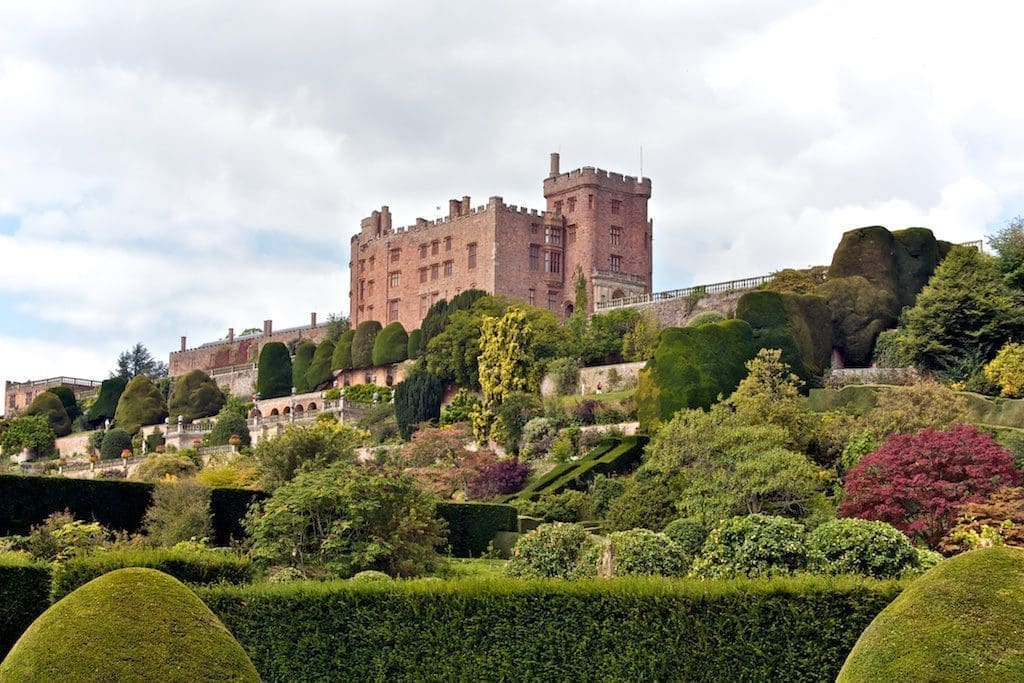Powis Castle is a magnificent medieval castle located near Welshpool in the heart of Powys, Wales.

With its soaring towers and opulent Baroque interior, it is considered one of the most iconic and well-known castles in all of Wales. For over 400 years, Powis Castle served as the cherished ancestral home of the Earls of Powis, a branch of the prominent Herbert aristocratic family.
Behind this remarkable castle lies a long and intricate history that is closely tied to the rise of the Herbert dynasty and the evolution of the sprawling Powis Estates surrounding it.
The lands around Powis Castle have a heritage stretching back over 900 years. The storied history of its ownership and architectural transformations provide a captivating window into the changing fates of Welsh nobility over the centuries. From its medieval origins to its Victorian-era heyday, Powis Castle has stood as a symbol of aristocratic tradition and prestige as well as an expression of evolving castle architecture and design trends across different eras. Its present grandeur is a testament to the lasting influence of the Herbert Earls who made it their family seat as they rose to power and prominence.
The Early History of Powis Estates
The origins of Powis Castle and its surrounding estate date back to 1085 when the area was granted by William the Conqueror to his followers after the Norman invasion of Wales. The castle and lands changed hands several times over the next few centuries between various Marcher Lords who ruled the Welsh Marches.
In the late 1300s, Powis Castle and estate came under the control of the Cherleton family, an aristocratic Welsh family descended from nobility. It was under the Cherletons that the first significant fortifications were likely constructed on this strategic high ground site near the Welsh border. They built up Powis as a formidable stronghold with imposing towers, curtain walls, and luxurious living quarters befitting the family’s status.
The Cherletons continued to expand the castle into a palatial complex. Architectural accounts show they added a magnificent new great hall and tower to the castle in the early 1400s. These early fortified medieval structures formed the core of what would later become the Powis Castle we know today. The estate also prospered under the Cherletons prior to the family line dying out in 1421. Their lasting medieval mark on the site was inherited by their successors at Powis.
The Herbert Family’s Ascent
A major shift occurred at Powis Castle and the surrounding estates when it was acquired by the prominent Herbert family in 1587. Sir Edward Herbert, an influential Elizabethan politician and soldier, purchased Powis Castle and the extensive estates from Lord Edward Somerset. This marked the beginning of over four centuries of continuous Herbert family ownership of Powis.
Sir Edward Herbert’s son, William Herbert, served as High Sheriff of Merionethshire and was made the 1st Baron Powis in 1629 under King Charles I. This marked the family’s rise to prominence as they were granted a noble title. William’s grandson, another William Herbert, was created 1st Marquess of Powis in 1674 by King Charles II in recognition of his loyalty. The title Earl of Powis was later added to the family in 1748.
An intriguing connection to the Herberts emerged through Clive of India, founder of Britain’s colonial empire in India. Clive was related to the Herberts through his mother. The enormous wealth Clive amassed during his conquests strengthened the family’s aristocratic standing. Over 400 years after Sir Edward Herbert first acquired Powis, his descendants maintained their ancestral seat there as one of the most powerful aristocratic families in Britain.
Powis Castle’s Evolution Under the Earls of Powis
Over the centuries under Herbert family ownership, Powis Castle underwent dramatic architectural transformations that reflected the tastes and ambitions of each successive Earl.
In the mid-1600s, the third Lord Powis carried out renovations to transform the castle interiors into an extravagant Baroque aristocratic palace. Intricate carvings, elegant furniture, and lavish fabrics were installed, creating a level of opulence befitting the family’s stature.
Under William Herbert, the first Earl of Powis, the exterior and layout of the castle were redesigned starting in 1670. The Italianate style was favored, giving the castle grand, ornate facades and Baroque details including balustrades and statues.
Later, in the Victorian era, the fourth Earl of Powis oversaw renovations that gave Powis Castle a more Gothic, medieval character. Mock battlements, towers, and turrets were added for a more imposing, fortified aesthetic.
Over four centuries of evolutions under successive Earls saw Powis Castle transformed from a medieval stronghold to a grand Baroque palace and then a Victorian castle. The tastes and ambitions of each Earl left an indelible, yet varied architectural mark on Powis.
The Modern Era at Powis
In the 20th century, Powis Castle entered a new phase as it passed from private aristocratic ownership into the public trust. This allowed its remarkable history and architecture to be widely appreciated as a cultural heritage site.
Lady Violet Herbert, wife of the fourth Earl Edward Powis, left a significant mark by redesigning the castle gardens in the early 1900s. She created an intricate parterre and terraced gardens with yew hedges, adding her own passion for horticulture.
The castle was inherited by her son Robert Clive, fifth Earl of Powis, in 1952. However, since he had no children of his own, he made the decision to bequeath the castle and gardens to the National Trust in the 1950s. This ensured its preservation for future generations.
Today, as part of the National Trust, Powis Castle and Gardens are a major historic tourism destination. Over 100,000 visitors a year marvel at the castle’s blend of medieval, Baroque, and Victorian architecture. The estate’s storied history is vividly retold and celebrated for all to discover. From aristocratic private home to public treasure, Powis now enters its newest chapter.
Centuries of Heritage
As explored throughout its long history, the storied heritage of Powis Castle and the surrounding estates is intricately intertwined. From its 13th century medieval roots to its Victorian architectural splendor in the 1800s, Powis Castle bore witness to centuries of changing heritage. Its evolving castle architecture under successive Earls of Powis provides a window into the tastes and ambitions of Welsh aristocracy across different eras.
The castle’s present grandeur pays tribute to the lasting influence of the Herbert family, whose rise to power and prominence is etched into the very stones of Powis. Their aristocratic family seat for over 400 years, it remained their cherished ancestral home until being entrusted to the nation in the 20th century. Powis Castle now stands as both an architectural jewel and historic time capsule, captivating visitors with its blend of medieval, Baroque, and Victorian styles. Its storied past remains very much alive, inviting discovery within its dramatic turrets and opulent rooms.
FAQ
Where is Powis Castle located?
Powis Castle is located just outside Welshpool, Powys in mid-Wales. The postal code for sat-nav is SY21 8RF. The castle is about 12 miles north of Montgomery and Welshpool is the nearest major town.
Are dogs allowed at Powis Castle?
Dogs on leads are welcome in the gardens but not inside the castle. Assistance dogs are allowed inside the castle. The tea room and restaurant on site are dog friendly.
Is there parking available at Powis Castle?
Yes, a dedicated parking area for cars and coaches is available on site. Parking is free for National Trust members and a charge per day for non-members.





